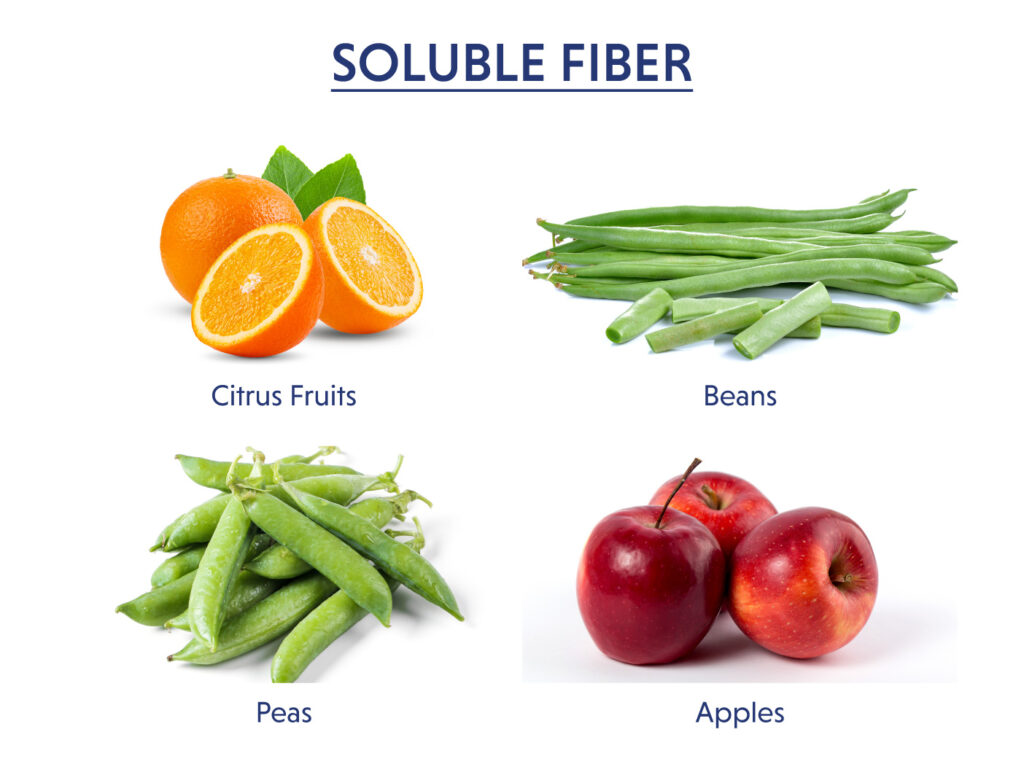Role Of Fibrous Foods In Gut Health And Disease
Our overall health majorly depends on the proper functioning of our gut microbes. This collection of gut microbes or gut microbiota is further affected by factors like stress, dietary changes, some underlying diseases, etc.
In this blog, we will dive into the topic- of the role of fibrous foods in gut health and disease. You may not be aware that fibrous foods or dietary fiber comprise the indigestible part of the plant. In medical terms, it is also known as ‘roughage.’ This unassimilated part of food passes relatively intact through the stomach, small intestine, large intestine, and finally out of your body.
The dietary fiber we intake has been classified into two groups:
Role Of Fibrous Foods In Gut Health And Disease
1) THE SOLUBLE FIBER

As the term indicates, it is the type of fiber that can dissolve in water and change its form into a gel-like material. A very beneficial form of fibrous foods, it has been proven to help reduce blood cholesterol and maintain glucose levels.
This variety of fiber is often found in oats, peas, beans, apples, citrus fruits, carrots, etc.
2) THE INSOLUBLE FIBER
This type of fiber cannot be digested by our body and so remains intact. It passes through our digestive system and out of the body in its original form. Therefore, including this fiber in your diet will add bulk to your stool and assist in the movement of material through the digestive system.
It is beneficial to those who have constipation or irregular stools.
Insoluble fiber is commonly found in whole wheat flour, wheat bran, nuts, beans, potatoes, etc.
However, if an individual intake the combination of soluble and insoluble fibers in their diet, it will help maintain normal intestinal functioning.
Both varieties of fibers will work together to maintain the stool’s consistency and aid in the digestion of other substances.
ROLE OF FIBROUS FOODS IN GUT HEALTH AND DISEASE
According to The Institute of Medicine, the daily fiber recommendation for children and adults varies between 25-35grams of fiber per day, whereas Americans get only 15grams per day.
Therefore, individuals must learn the health benefits of eating more fiber for healthy gut functioning.
1) IMPROVES IRREGULAR STOOLS
Fibrous foods help increase the weight and size of stool and soften it. A bulky stool is easier to pass and relieves some chronic conditions like constipation.
The loose and watery stools can also be treated with dietary fiber. Fiber solidifies the stool as it absorbs the water and adds bulk. Hence, bowel consistency can be maintained by bringing a little change in your diet.
2) AIDS IN ACHIEVING A HEALTHY WEIGHT
High fiber foods are filling but are less energy dense and have lower calories for the same volume of food. Therefore, one tends to eat less and stay satisfied longer. Hence, fibrous food proves to be very beneficial when it comes to weight reduction.
3) REGULATES BODY’S BLOOD SUGAR LEVEL
As it’s known that our body is unable to absorb and break down fiber, unlike carbohydrates, fiber cannot cause a spike in blood sugar. Moreover, the function of fiber is to keep a check on hunger and also aid in maintaining blood sugar in the target range.
Therefore, fibrous foods play a very important role in reducing the risk of type-2 diabetes.
4) MAINTAINS THE CHOLESTEROL LEVELS
Soluble fiber reduces the absorption of cholesterol into the bloodstream. Adding oatmeal or fruits like bananas or berries to your breakfast will reduce your bad cholesterol. An example of the bad cholesterol commonly found in our blood is low-density lipoprotein(LDL) cholesterol.
5) GOOD FOR GUT BACTERIA
A fibrous diet feeds the gut bacteria or gut microbes. They ferment and digest the fiber and, in turn, increase in number and kind.
An increased variety of gut microbes will be beneficial for the healthy functioning of the digestive system and for maintaining the mucosal lining. The mucosal lining, in turn, protects the gastrointestinal wall, thus preventing many inflammatory diseases like Colitis, Crohn’s disease, etc.
WAYS TO INCORPORATE FIBROUS FOODS INTO YOUR DIET
1) Do not stick to one variety of fiber
One must include a wide variety of high-fiber foods in their diet. Different types of fibers have different health benefits. Some high-fiber foods that we must opt for are beans, broccoli, berries, avocado, popcorn, whole grains, nuts, etc.
2) Start low and go slow
One must not start with too much fiber too quickly. Your natural bacteria of the digestive system need to adjust to the change. Increasing fiber impulsively can lead to the development of unwanted side effects such as:
a) Gas and bloating in some people due to the amount or type of fiber they intake
b) In some individuals, constipation or the symptoms of irritable bowel syndrome may worsen. For example, in Crohn’s disease, narrowing in the intestine occurs, and fiber can cause blockage of the bowel.
3) Prefer whole foods
Whole foods are naturally rich in fiber and so must be preferred over fiber supplements. Supplements such as Citrucel and Fibercon do not provide a variety of fibers, vitamins, minerals, and other essential nutrients.
Although some people can take supplements if dietary changes are insufficient or if they have certain medical conditions like constipation, diarrhea, and irritable bowel syndrome.
4) Avoid refined or processed foods
Refined foods have to undergo a process of grain refining that removes the outer coat (bran) from the grain. In addition, processed foods have added preservatives that affect their fiber content.
5) Drink plenty of water

Fiber works best when it absorbs water, adding bulk to your stool and making it soft.
CONCLUSION
We must understand and acknowledge the role of fibrous foods in gut health and disease for the smooth functioning of our digestive tract as we all know that ‘A healthy stomach paves the way to a healthy you. Hence, stay mindful of what you eat by bringing a little change to your diet. A healthy diet will not cost you much time but will benefit you extensively. Download the JOYSCORE APP and enjoy your life with happiness and satisfaction.
Download the Joyscore app Now!
Download on the Appstore
Get it on Google Play



